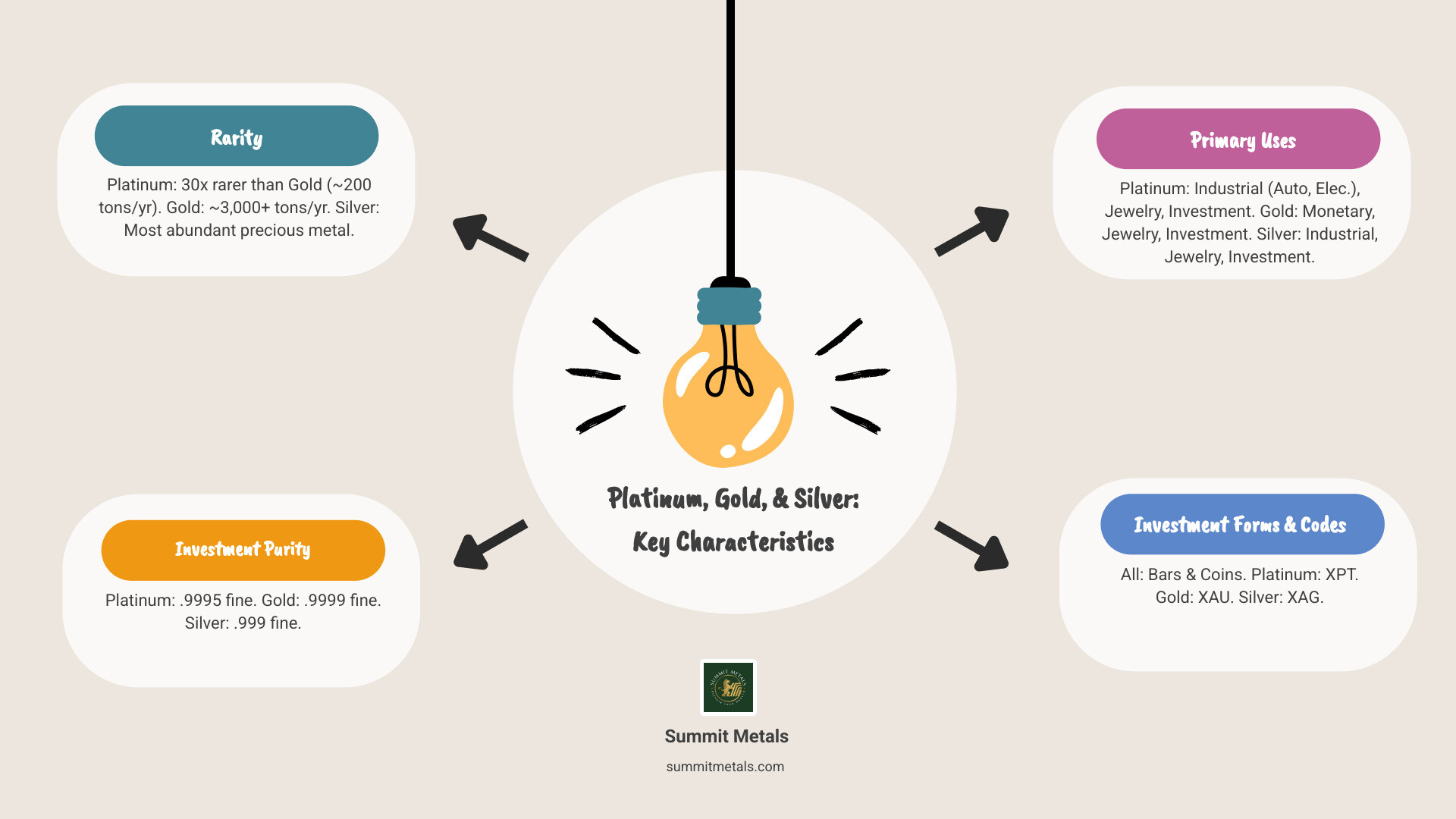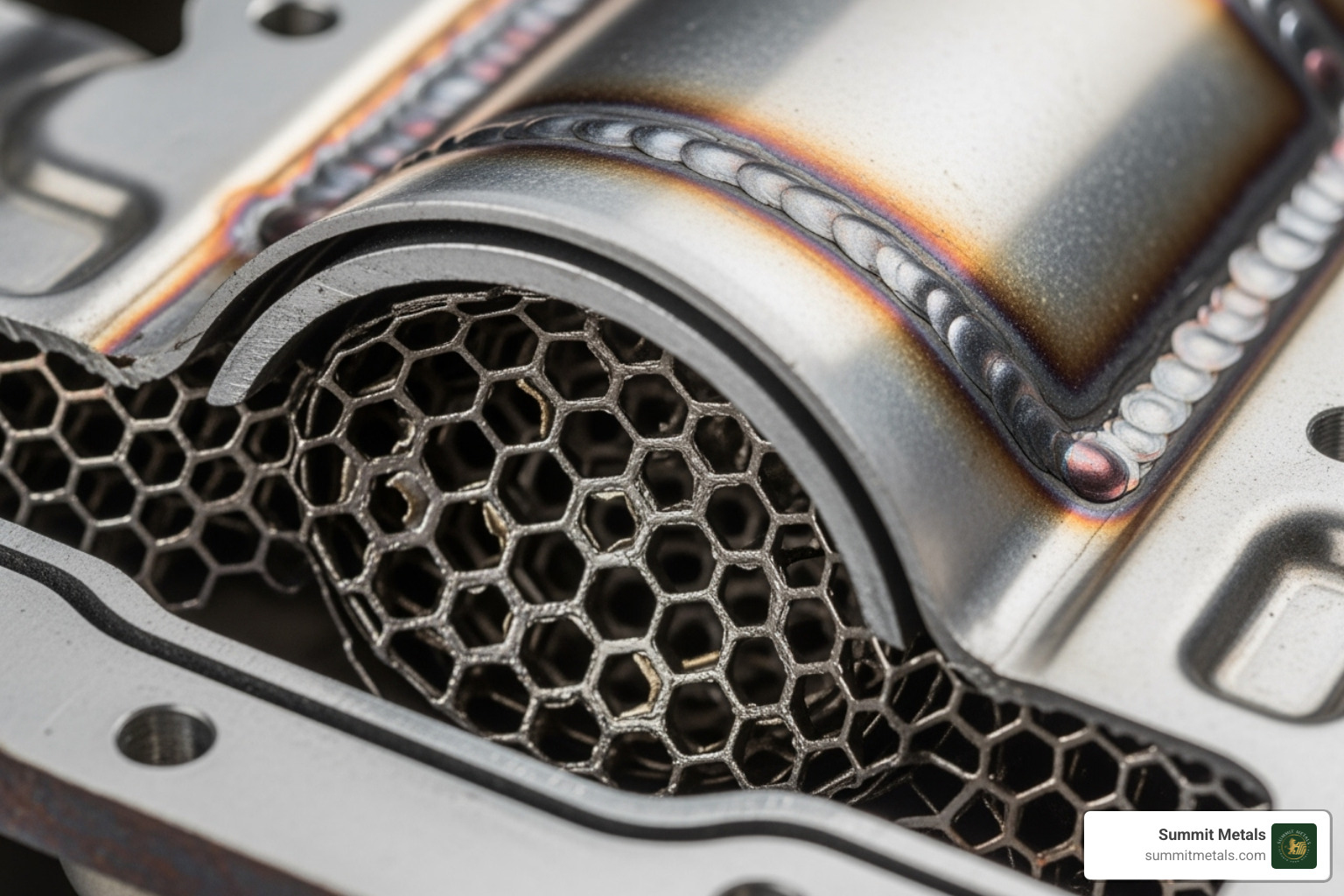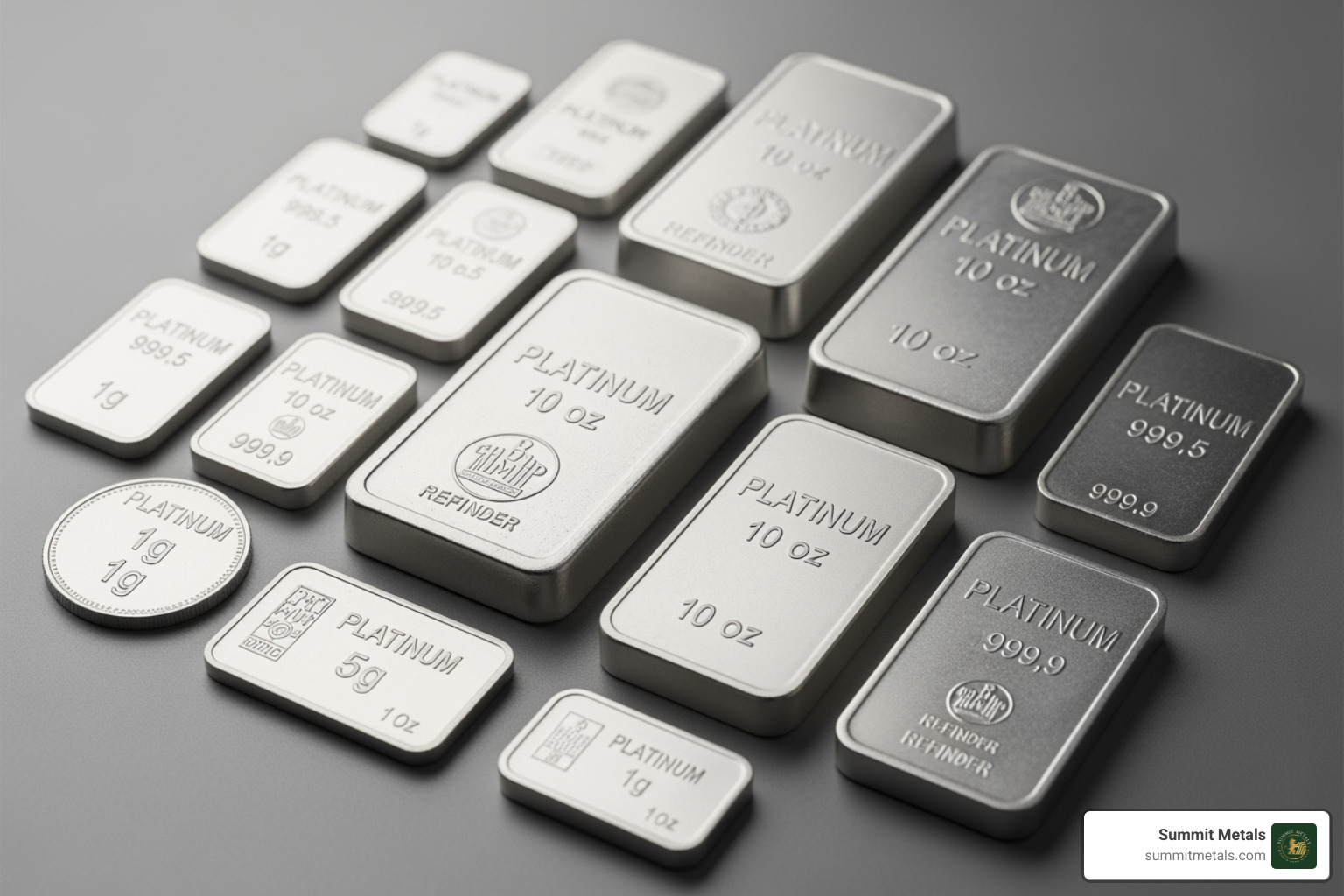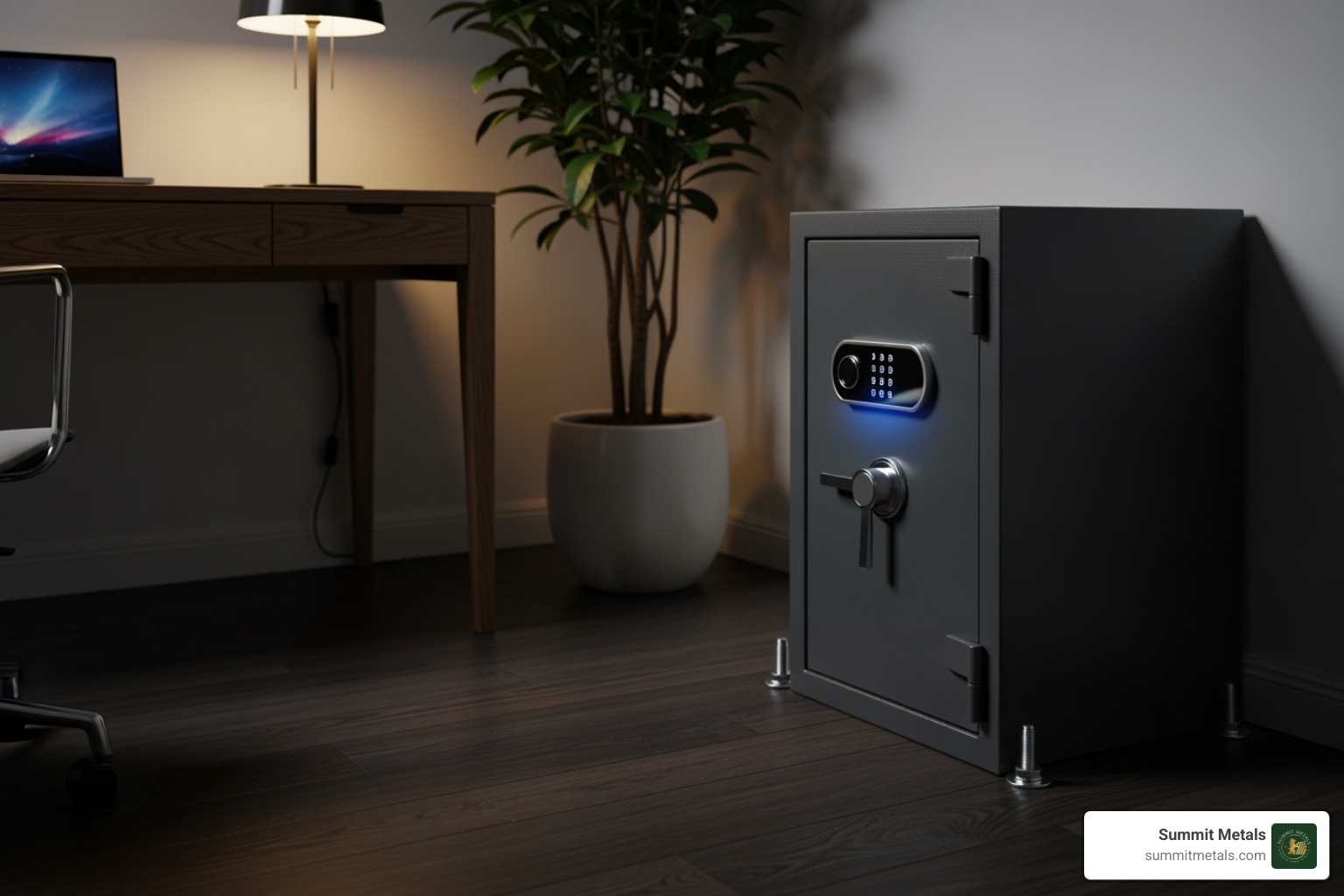Why Platinum Bullion Commands Attention in Today's Investment Landscape
What is platinum bullion represents one of the most exclusive ways to own physical precious metals. It is refined platinum formed into investment-grade bars and coins with a guaranteed purity of 99.95% (.9995 fine) or higher. Valued for its precious metal content, it's a pure play on platinum's market price. These products are measured in troy ounces (31.1035 grams) and use the international currency code XPT.
King Louis XV of France once declared platinum "the only metal fit for a king," a sentiment that holds true today. Platinum is 30 times rarer than gold, with annual production of only around 200 tons compared to gold's 3,000+ tons.
Unlike gold, platinum serves dual roles as both a precious metal investment and a critical industrial component. Over 40% of its supply is used in automotive catalytic converters, with more supporting electronics, medical devices, and jewelry. This industrial demand creates unique price dynamics, offering diversification for investors.
As Eric Roach, with a Wall Street background in structuring defensive portfolios, I've seen how platinum's industrial backing complements traditional precious metals allocations for clients exploring alternatives to gold and silver.

What is Platinum Bullion and Why is it Valuable?
As savvy investors look to diversify, platinum has emerged as a vital player. Let's explore what is platinum bullion and why it holds such significant value.
Defining Platinum Bullion: Purity and Standards
When we talk about what is platinum bullion, we mean platinum in its purest investment form—not jewelry. It comes in standardized bars, coins, or rounds with a guaranteed minimum purity of 99.95% fineness (.9995 pure). This ensures its value is tied directly to its metal content. Bullion adheres to strict weight standards, primarily the troy ounce (31.1035 grams), and is recognized globally with the currency code XPT. Top-tier bars meet the "Good Delivery" standards of the London Platinum and Palladium Market (LPPM), guaranteeing quality and authenticity.
The Rarity and History of Platinum
A key driver of platinum's value is its rarity—it's about 30 times rarer than gold. The entire amount ever mined could reportedly fit in a single living room. First identified in the West in 1735, it was initially dismissed by Spanish explorers as "platina" or "little silver." Its unique properties were appreciated later, leading Russia to mint platinum currency from 1828 to 1845. Modern platinum bullion coins began regular production in 1983, with popular series like the American Platinum Eagle following.
Key Drivers of Platinum's Demand
Platinum's value is also rooted in its diverse industrial applications.

The automotive sector is the largest consumer, using over 40% of the annual supply for catalytic converters to reduce emissions. Other critical uses include:
- Electronics: In computer hard disks and specialized wiring.
- Medical Field: In life-saving chemotherapy drugs, pacemakers, and medical instruments.
- Jewelry: For high-end, durable, and hypoallergenic pieces.
- Investment Demand: While a smaller portion, the demand for platinum bullion bars and coins provides a consistent base, with investors seeking diversification and a hedge against economic uncertainty.
Understanding these demand drivers helps us appreciate why platinum is a strategic asset with deep industrial roots. To explore how other precious metals fit into this picture, we invite you to read our insights on A Brief History of Gold as Currency and Store of Value.
Exploring Platinum Bullion Products: Coins vs. Bars
Once you understand what is platinum bullion, the next step is to explore the common forms for ownership: bars and coins.
An Investor's Guide to Platinum Bars
Platinum bars are a straightforward way to invest, often carrying lower premiums over the spot price than coins due to simpler manufacturing.

They are stamped with their weight, .9995 purity, and the refiner's mark, with many including a unique serial number for security. Bars are available in sizes from 1 gram to 10 ounces and larger, offering flexibility for any budget. Always choose bars from reputable mints and refiners to ensure authenticity and liquidity.
Popular Platinum Bullion Coins
Platinum coins blend investment value with artistry. Issued by government mints, they have a legal tender status, which adds a layer of authenticity. It's important to distinguish bullion value (based on metal content) from numismatic value (based on rarity or collectibility). Most platinum coins are valued for their bullion content. We offer renowned platinum coins, including:
- American Platinum Eagle: The official U.S. platinum coin, minted since 1997.
- Canadian Maple Leaf: Known for its high purity and security features.
- Austrian Philharmonic: A popular European coin celebrating the Vienna Philharmonic.
- British Britannia: The Royal Mint's classic design in platinum.
- Australian Platinum Kangaroo: From the Perth Mint, featuring Australia's iconic animal.
- Somalian Platinum Elephant: Part of the popular African Wildlife series.
Each of these coins boasts a minimum .9995 purity and offers investors a tangible, internationally recognized asset.
What is Platinum Bullion's Role in an IRA?
Platinum bullion can be a powerful asset in a Precious Metals IRA, offering diversification for your retirement. The IRS has strict IRA eligibility requirements: bullion must meet a minimum fineness of .9995. The American Platinum Eagle and Canadian Platinum Maple Leaf are popular IRA-eligible coins, as are platinum bars from accredited refiners.
Including platinum in an IRA provides a hedge against inflation and economic volatility with a tangible asset. To build your holdings steadily, Summit Metals' Autoinvest feature lets you buy platinum bullion every month, similar to a 401k plan. This dollar-cost averaging strategy simplifies building your portfolio over time.
To learn more about how precious metals can fit into your retirement strategy, explore our guide on Precious Metals IRAs.
Investing in Platinum: A Comparison and Strategy Guide
Now that we understand what is platinum bullion, let's see how it compares to gold and silver and what strategies to consider.
Platinum vs. Gold and Silver: An Investment Perspective
Each precious metal has a unique role. While all are stores of value, their demand drivers and price behaviors differ dramatically.
| Characteristic | Platinum | Gold | Silver |
|---|---|---|---|
| Rarity | 30x rarer than gold; only ~200 tons mined annually | Still rare, but more abundant than platinum; ~3,000+ tons mined annually | Most abundant of the three; ~27,000+ tons mined annually |
| Primary Uses | Industrial (automotive catalysts, electronics, medical); Jewelry; Investment | Monetary (store of value, currency hedge); Jewelry; Investment | Industrial (electronics, solar, medical); Jewelry; Investment |
| Price Volatility | Can be highly volatile due to industrial demand; more tied to economic cycles | Generally less volatile; often seen as a safe haven during uncertainty | Can be highly volatile due smaller market size and industrial demand |
| Market Size | Third most traded precious metal | Largest and most liquid precious metal market | Second largest precious metal market |
Historically, platinum often traded at a premium to gold. In recent years, this has inverted, with platinum often costing less. This shift is due to factors like quantitative easing (boosting gold) and changing automotive demand. This price relationship may represent an opportunity for investors who see platinum's fundamental value.
Platinum's price is more tied to the global economy due to its industrial use, while gold often performs best during economic uncertainty. This difference makes them excellent for diversification. For more on this, see Why Gold and Silver: Understanding Their Value as Safe Haven Assets.
Benefits and Risks of Platinum Investment
Investing in platinum bullion offers distinct advantages and risks.
Benefits:
- Portfolio Diversification: Its price doesn't always move in lockstep with gold, silver, or stocks.
- Hedge Against Inflation: It's a tangible asset that holds value when currencies weaken.
- High Liquidity: Popular coins and bars are easily bought and sold globally.
- Strong Industrial Demand: Consistent use in vital sectors provides a solid value foundation.
Risks:
- Price Volatility: Can be more volatile than gold, especially during economic downturns.
- Automotive Dependence: Its price is sensitive to shifts in the auto industry.
- Geopolitical Supply Concentration: Over 70% of supply comes from South Africa, with Russia as another major producer, making it vulnerable to regional instability.
For more perspective on building a diversified approach, consider the insights on The importance of diversification.
Factors That Influence Platinum Prices
Several key forces move platinum prices:
- Supply and Demand: The core driver, influenced by mining output and industrial consumption.
- Automotive Industry Health: As the largest consumer, vehicle production trends and emissions regulations are critical.
- Jewelry Demand: Economic prosperity in key markets can boost demand.
- Mining and Geopolitics: Labor stability and political events in South Africa and Russia can cause significant price swings.
- U.S. Dollar Strength: A stronger dollar can make platinum more expensive for foreign buyers, while a weaker dollar can boost demand.
These factors create opportunities for disciplined investors. Summit Metals' Autoinvest feature helps you take advantage of price fluctuations through dollar-cost averaging. By making regular monthly purchases, like a 401k contribution, you can build your position steadily without trying to time the market. For more on these forces, see our article on Key Factors Influencing Gold & Silver Prices: Supply, Demand, Geopolitics.
How to Buy and Secure Your Platinum Bullion
You've learned what is platinum bullion and why it's valuable. Now comes the practical part: acquiring and protecting your investment.
Finding a Reputable Dealer
Choosing the right dealer is the foundation of a secure investment. Look for transparent pricing, where the spot price and premium are clearly stated. At Summit Metals, our real-time pricing reflects our bulk purchasing power, passing savings to you. Check reviews and credentials to verify a dealer's reputation. Avoid high-pressure sales tactics; a trustworthy dealer educates and allows you to make informed decisions. Finally, verify authenticity by sticking to products from recognized sovereign mints and established private refiners. This ensures your investment is liquid and valuable worldwide. For more guidance, see our guide on How to Buy Gold and Silver Online Safely.
Secure Storage Options for Your Investment
Protecting your platinum is crucial.

- Home Storage: Suitable for smaller collections. Use a high-quality, bolted-down, fireproof safe. Keep detailed records for insurance.
- Bank Safe Deposit Boxes: More secure than home storage, but contents are not typically insured by the bank.
- Third-Party Depositories: The highest level of security for serious investors. These facilities offer climate control, full insurance, and options for segregated (your specific items) or allocated (your title to metal in a pool) storage. This is often required for IRAs.
Regardless of your choice, ensure you have adequate insurance for your holdings.
What is Platinum Bullion Autoinvesting?
You don't need a large lump sum to invest in platinum. Dollar-cost averaging is a powerful strategy for building wealth steadily. By investing a fixed amount at regular intervals, you buy more ounces when prices are low and fewer when they are high. This approach mitigates price volatility and can lower your average cost per ounce over time.
Summit Metals' Autoinvest feature makes this effortless. It allows you to buy platinum bullion every month just like investing in a 401k. You set the amount, and the system automatically builds your position, removing the stress of market timing. It's a simple, disciplined way to make precious metals a regular part of your wealth-building strategy.
Frequently Asked Questions about Platinum Bullion
We've covered a lot about what is platinum bullion. Here are answers to the most common questions.
Is platinum a better investment than gold?
It's like asking if a hammer is better than a screwdriver. They are different tools for your portfolio. Gold is a classic safe haven, thriving on economic uncertainty. Platinum is more of an industrial metal, with its price often tied to economic growth, particularly in the auto sector. Historically, platinum traded at a premium to gold; today, it's often less expensive, which some investors see as a value opportunity. The best strategy often involves holding both for diversification. They complement each other, with gold providing stability and platinum offering exposure to industrial growth.
How can I be sure my platinum bullion is real?
Protecting yourself from counterfeits is straightforward.
- Buy from reputable dealers: This is your best defense. Summit Metals sources directly from trusted mints and refiners, guaranteeing authenticity.
- Look for mint marks and purity stamps: Genuine bullion is clearly stamped with its weight, purity (.9995 fine), and the mint or refiner's hallmark.
- Understand basic tests: Platinum is very dense (heavy for its size) and non-magnetic.
If a deal seems too good to be true, it almost certainly is. Stick with established dealers who provide documentation. For more on verification, our guide on How to Tell if Gold is Real offers principles that apply to all precious metals.
Which platinum products are eligible for an IRA?
Yes, you can hold platinum bullion in your IRA, but the IRS has specific rules.
- Purity Requirement: The platinum must be at least .9995 fine.
- Approved Products: Coins must be from government mints, and bars must be from accredited refiners.
The American Platinum Eagle and Canadian Platinum Maple Leaf are popular IRA-approved coins. Bars from refiners like PAMP Suisse and Valcambi also typically qualify. Always consult with your financial advisor and IRA custodian to confirm eligibility. For more details, check out our guide on Learn more about Precious Metals IRAs.
Conclusion: Is Platinum Bullion Right for Your Portfolio?
After exploring what is platinum bullion, it's clear this metal is unique. Its extreme rarity—30 times rarer than gold—and its critical industrial demand give it a distinct investment profile. Platinum acts as both a store of value and an industrial powerhouse, offering powerful diversification potential that can complement gold and silver.
Owning physical platinum provides a tangible, strategic hard asset in an uncertain world. Building a position is easier than ever. With our Autoinvest feature, you can buy platinum bullion every month just like investing in a 401k, using dollar-cost averaging to grow your portfolio steadily.
At Summit Metals, we are your trusted partner, offering transparent pricing and authenticated products. Consider how platinum's unique qualities fit your financial strategy. To learn more, explore The Ultimate Beginner's Guide to Investing in Precious Metals.



